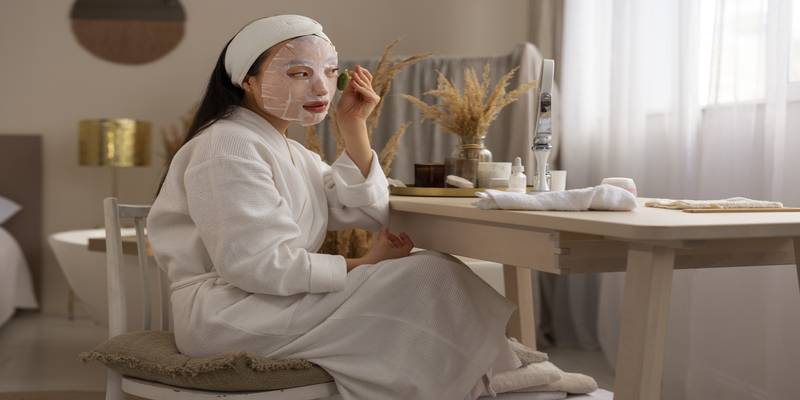Here’s why SPF is your BFF

Summers and sunscreen go hand in hand. Most of us can relate to slathering sunscreen under the scorching heat as covering the exposed parts of the body is the need of the hour. But is it equally important during other seasons? Or indoors? If yes, why?
What is sunscreen?
Imagine it as a shield that protects your skin from tanning. The sun rays are extremely harmful that can damage your skin and cause skin cancer, melasma, and melanoma, among other diseases. Ultraviolet A (UVA) is responsible for issues such as premature ageing of the skin, and wrinkles. At the same time, long-term unprotected exposure to ultraviolet B (UVB) rays may cause skin cancer and other skin-related ailments.
What are UVA and UVB rays?
To understand UVA and UVB rays, let’s first decipher what tanning is. When UVA rays touch lower layers of our skin, it tends to produce a pigment called Melanin. Melanin is a brown pigment secreted by our skin to block the UV rays. Think of it as our skin’s defence mechanism. This pigment causes our skin to look brown or what we call ‘tanned’. UVA is the type of ray that penetrates deeper layers of our skin due to its longer wavelength. Hence, it can interfere with the DNA. UVB rays have shorter wavelengths and can cause skin burning, sun spots, hyperpigmentation, freckling basal, and squamous cell carcinoma. However, getting tanned or acquiring that ‘healthy glow’ is something that a lot of us seek. Rather than going for a sunbath or tanning beds, we can switch to sunless tanners as these are creams that mimic melanin but are not melanin.
Why apply sunscreen?
Pigmentation, dark spots, dry hair, dull skin, patchy skin, and so on… many of us would relate to having faced such issues. Being a victim myself, I can say that these concerns are very common. Fortunately, it can be dodged away by maintaining a healthy and right skin care routine with sunscreen being a crucial part of it.
How does sunscreen work?
Sunscreen works by screening, absorbing, or blocking ultraviolet rays through a combination of physical and chemical particles. There are two types of sun protectants — chemical sunscreen (known as sunscreen) and physical sunscreen (known as sunblock or mineral sunscreens). Both are sun protectants, but the way they provide protection from UV rays is different.
Sunscreen
– Prevents the risk of skin cancer and other skin-related issues
– Protects from premature ageing of the skin, blotching, and pigmentation
– Reduces skin redness, inflammation, and shields the DNA
Sunscreen or chemical sunscreen, which is most commonly used, works by filtering, screening, and absorbing sun rays while letting some of it sink into the skin. These sunscreens usually contain chemicals such as oxybenzone, octisalate, octocrylene, homosalate, octinoxate, and avobenzone. Once UV rays penetrate the skin, these chemicals create a reaction and dissipate the harmful rays out from the skin in the form of heat — the reason some of us endure clogged pores and suffer acne.
The heat can cause trouble to people with oily and combination skin types but the after-effects are far less severe than unprotected exposure to UV rays. Fortunately, some brands manufacture lightweight and non-comedogenic sunscreens, which can be safely used by those with oily skin. Popular non comedogenic sunscreen ingredients to look out for are zinc oxide and titanium dioxide. At the same time, a mineral sunscreen simply acts as a shield that sits on our skin and deflects UV rays. It prevents the penetration of UV rays into the skin, unlike chemical sunscreens. Since the mineral sunscreen is a shield on the skin, it can also clog pores.
Which is better: physical or chemical?
According to the US Food and Drug Administration (FDA), either type of sunscreen has not been tagged as unsafe. However, the FDA did propose additional safety for a few chemicals generally present in chemical sunscreens. The reason is that such chemicals (oxybenzone, avobenzone, octisalate, octocrylene, homosalate, and octinoxate) dissolve in the bloodstream. However, the ill effects of not using sunscreen outweigh the risk of absorption of sunscreen chemicals into the bloodstream.
Another concerning factor when it comes to the usage of chemical sunscreens is that oxybenzone is found in them and it may bleach and damage coral reefs. Hence, it is advised not to use chemical sunscreens while swimming in oceans. Interestingly, Hawaii has banned oxybenzone for the same reason. On the other hand, physical sunscreens reflect UV rays rather than absorbing them. Hence, the composition of physical or mineral sunscreens are safe to be applied onto the skin.
Chemical sunscreen
Pros
It is easy to apply and is thinner in consistency. Some do not leave a white cast on the skin. Reapplication time is two to three hours.
Cons
Takes 15-20 minutes to start working. It can cause allergic reactions to some people. Not recommended to those with sensitive skin and should not be used while swimming in the ocean. The heat dissipation can worsen melasma.
Mineral or physical sunscreen
Pros
It is safer as it contains ingredients such as titanium dioxide and zinc oxide. Ideal for people with sensitive skin. Absorbs quickly and functions instantly.
Cons
It can leave a white cast. It is thick in consistency and may clog pores. Needs to be reapplied more frequently as compared to chemical sunscreen.
What to look for when you buy sunscreen?
Broad-spectrum, SPF, and PA? Do these terms sound familiar? We see these written on the packaging and bottles but don’t know what it means. These are the three primary factors that help determine how much sunscreen can protect you from sun rays.
SPF is your BFF
SPF stands for sun protection factor. It determines how much the sunscreen can protect your skin from UVB rays before it starts burning. How fast one’s skin starts burning differs from person to person, depending on the skin type and colour. For example, my skin tends to burn within 10 minutes of sun exposure, and I wear sunscreen with SPF 15. In that case, SPF 15 will most likely protect my skin from burning for roughly 150 minutes. Basically, multiply the time your skin takes once it starts burning with the SPF to get an idea. The higher the SPF, the longer you can protect your skin from burning.
PA or PA ++ or PA +++ ?
PA is a grading system to measure protection from UVA rays, a method devised by the Japanese. However, the said grading system is not approved by the FDA. Hence, some of us won’t see PA or PA ++ marks on the American or European Union-formulated products. So, what is the fuss behind the plus(s)? It is a range of protection from UVA. The more pluses (four is the maximum), the higher the protection.
Broad-spectrum
As the term suggests, broad-spectrum provides maximum coverage from both UVA and UVB rays. You would generally see a broad spectrum written on the label with SPF or SPF with PA (and the pluses) or even just a broad spectrum.
When and how to apply sunscreen?
ALL THE TIME! Yes. Be it indoors, outdoors, going for a swim, in sunny or overcast weather — it should be a yearly thing. Make it a habit to inculcate sunscreen application in your skincare routine. Try and apply sunscreen 15-20 minutes before stepping out and make sure to reapply it after two-three hours, if you plan on spending some generous time in the sun.






